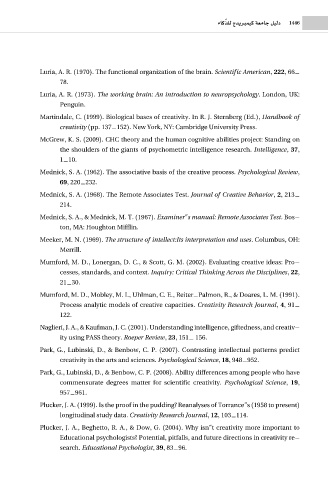Page 1447 - theCambridgehandbookofintelligence1
P. 1447
AÉcòs ∏d êójôѪ«c á©eÉL π«dO 1446
Luria, A. R. (1970). The functional organization of the brain. Scientific American, 222, 66-
78.
Luria, A. R. (1973). The working brain: An introduction to neuropsychology. London, UK:
Penguin.
Martindale, C. (1999). Biological bases of creativity. In R. J. Sternberg (Ed.), Handbook of
creativity (pp. 137-152). New York, NY: Cambridge University Press.
McGrew, K. S. (2009). CHC theory and the human cognitive abilities project: Standing on
the shoulders of the giants of psychometric intelligence research. Intelligence, 37,
1-10.
Mednick, S. A. (1962). The associative basis of the creative process. Psychological Review,
69, 220-232.
Mednick, S. A. (1968). The Remote Associates Test. Journal of Creative Behavior, 2, 213-
214.
Mednick, S. A., & Mednick, M. T. (1967). Examiner s manual: Remote Associates Test. Bos-
ton, MA: Houghton Mifflin.
Meeker, M. N. (1969). The structure of intellect:Its interpretation and uses. Columbus, OH:
Merrill.
Mumford, M. D., Lonergan, D. C., & Scott, G. M. (2002). Evaluating creative ideas: Pro-
cesses, standards, and context. Inquiry: Critical Thinking Across the Disciplines, 22,
21-30.
Mumford, M. D., Mobley, M. I., Uhlman, C. E., Reiter-Palmon, R., & Doares, L. M. (1991).
Process analytic models of creative capacities. Creativity Research Journal, 4, 91-
122.
Naglieri, J. A., & Kaufman, J. C. (2001). Understanding intelligence, giftedness, and creativ-
ity using PASS theory. Roeper Review, 23, 151- 156.
Park, G., Lubinski, D., & Benbow, C. P. (2007). Contrasting intellectual patterns predict
creativity in the arts and sciences. Psychological Science, 18, 948-952.
Park, G., Lubinski, D., & Benbow, C. P. (2008). Ability differences among people who have
commensurate degrees matter for scientific creativity. Psychological Science, 19,
957-961.
Plucker, J. A. (1999). Is the proof in the pudding? Reanalyses of Torrance s (1958 to present)
longitudinal study data. Creativity Research Journal, 12, 103-114.
Plucker, J. A., Beghetto, R. A., & Dow, G. (2004). Why isn t creativity more important to
Educational psychologists? Potential, pitfalls, and future directions in creativity re-
search. Educational Psychologist, 39, 83-96.

